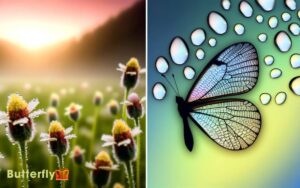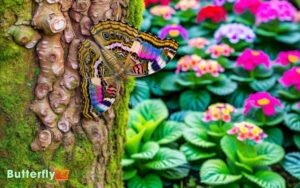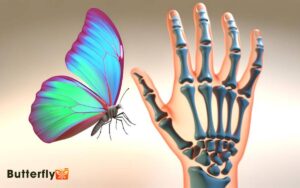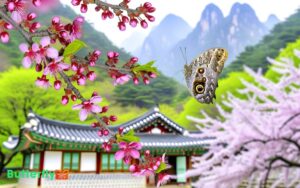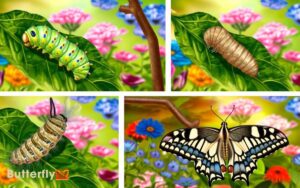Do Butterflies Pollinate Like Bees? Exploring Differences!
Butterflies and bees both pollinate, but they do it differently. You’ll see butterflies using visual cues to find flat, colorful flowers, while bees rely on scent and target tubular flowers.
Despite their erratic flight, they contribute to plant genetic diversity. These differences in pollination techniques between butterflies and bees are essential for healthy ecosystems. To understand the deeper dynamics, let’s explore further.
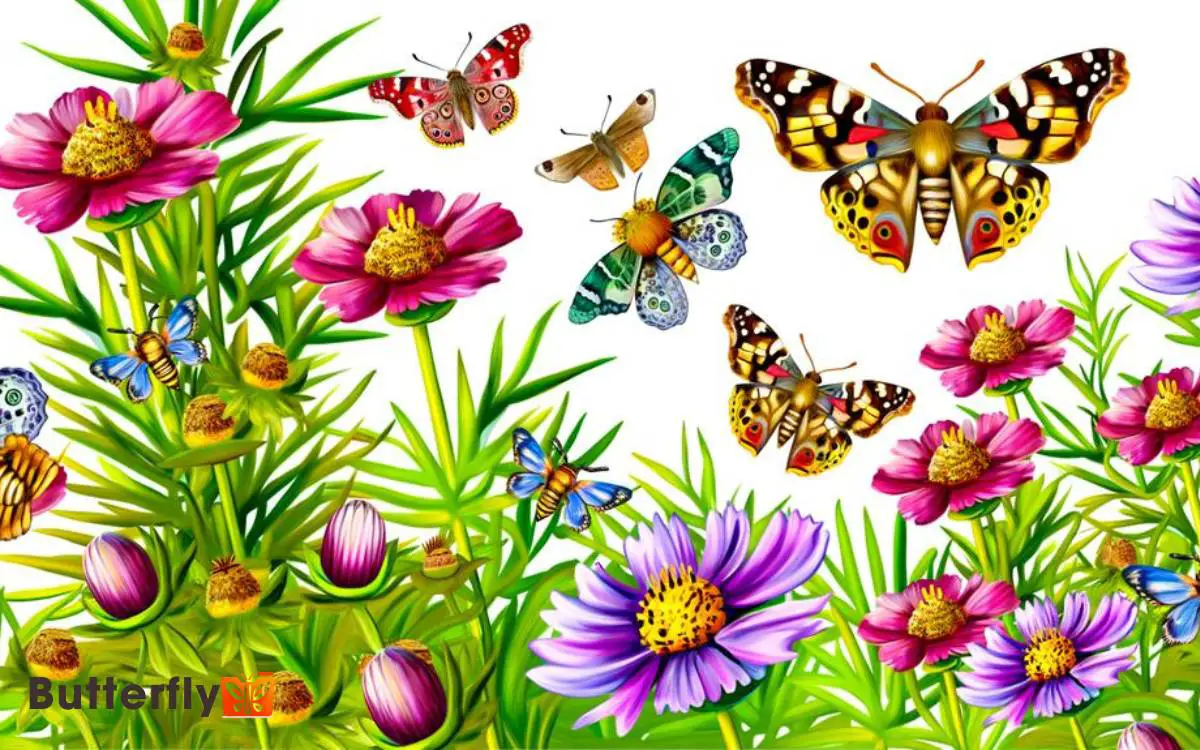
Key Takeaways
Butterfly Pollination Basics
Butterfly pollination hinges on the intricate relationship between butterflies and flowering plants. When a butterfly lands on a flower, its proboscis unfurls to reach deep into the flower’s nectar source. As the butterfly feeds, its body brushes against the flower’s reproductive structures, transferring pollen from one bloom to another. This exchange is crucial for the fertilization of many plant species, ensuring the production of seeds and fruits. The butterfly pollination process highlights the vital role these insects play in maintaining biodiversity and ecosystem stability.
As it does, pollen grains attach to its body, particularly on its legs and proboscis. The butterfly then moves to another flower, inadvertently depositing this pollen onto the flower’s reproductive structures.
This process, though less efficient than bee pollination, still contributes immensely to the reproductive success of many plant species.
By understanding the specifics of this interaction, you can appreciate the subtle yet crucial role butterflies play in maintaining ecological balance and promoting biodiversity in various ecosystems.
Differences in Pollination Techniques
Understanding the differences in pollination techniques between butterflies and other pollinators like bees and birds reveals the unique adaptations and ecological roles each species fulfills.
Butterflies rely on visual cues and prefer bright colors, while bees are more attuned to scent and specific flower structures.
Butterflies often visit flat, clustered flowers for ease of landing, whereas bees can access tubular flowers with their specialized mouthparts. Birds, on the other hand, are drawn to red or orange flowers and can pollinate while hovering.
Here are four fascinating aspects to explore:
- Visual vs. Olfactory Cues: Butterflies use sight, bees use smell.
- Flower Shape Preference: Butterflies prefer flat clusters; bees like tubular shapes.
- Pollination Efficiency: Bees are generally more efficient pollinators.
- Nectar Access: Butterflies use long proboscises, while bees have versatile mouthparts.
Anatomy of Butterflies Vs. Bees
In comparing the anatomy of butterflies and bees, you’ll notice several key differences that highlight their distinct evolutionary paths and specialized roles in pollination.
Butterflies possess long, coiled proboscises designed to reach deep into tubular flowers for nectar. Their light, fluttering wings enable them to hover and navigate efficiently.
Conversely, bees have shorter proboscises but feature hairy bodies that trap pollen. Their robust legs contain specialized pollen baskets (corbiculae) for transporting pollen back to their hives.
Additionally, bees exhibit a compact, aerodynamic body shape optimized for rapid, direct flight between flowers.
These anatomical distinctions underscore their differing pollination techniques and preferences, reflecting adaptations to their unique ecological niches and behaviors within the pollination process.
Types of Flowers Butterflies Prefer
You’ll notice butterflies are particularly drawn to brightly colored blooms, which stand out in their visual spectrum.
They also favor scented floral choices that help guide them to nectar sources.
Additionally, butterflies prefer open and flat flowers, making it easier for them to land and feed efficiently.
Brightly Colored Blooms
Butterflies are particularly attracted to brightly colored blooms such as zinnias, marigolds, and lantanas, which provide the essential nectar they need for sustenance. These vivid flowers not only catch a butterfly’s eye but also offer a rich source of energy.
The specific traits that make these blooms irresistible include:
- Vivid Colors: Bright reds, oranges, and yellows act as visual beacons.
- Nectar-Rich: High nectar content guarantees butterflies get enough nourishment.
- Flat-Topped Clusters: Flowers like lantanas provide easy landing platforms.
- Long Blooming Periods: Extended flowering times secure consistent food sources.
Scented Floral Choices
Amidst the myriad of floral options, butterflies show a significant preference for flowers emitting sweet, alluring scents, which serve as olfactory cues guiding them to nectar sources.
You’ll find that these scents are vital for butterflies, as their olfactory receptors are finely tuned to detect specific volatile compounds.
Flowers like heliotrope and sweet alyssum are particularly attractive due to their strong, sweet fragrances. Butterflies rely on these scents to locate food efficiently, making them indispensable for their survival.
Open and Flat Flowers
While the allure of sweet fragrances plays an essential role in attracting butterflies, the structure of the flowers themselves also strongly influences their preferences, with open and flat flowers being particularly favored.
These types of flowers provide easy access to nectar, accommodating the butterfly’s long proboscis. By choosing flowers with flat surfaces, butterflies can land comfortably and feed without expending much energy.
Scientific studies suggest that butterflies prefer flowers that offer:
- Ample landing space – Ensuring stability during feeding.
- Accessible nectar – Allowing efficient energy intake.
- Vibrant colors – Appealing to their visual senses.
- Clustered arrangements – Facilitating quick movement between flowers.
Understanding these preferences helps you create a butterfly-friendly garden, fostering biodiversity and enhancing pollination.
Impact on Plant Reproduction
Pollination by butterflies greatly enhances the genetic diversity of plant populations, thereby boosting their adaptability and resilience to environmental changes. When butterflies visit multiple flowers, they transfer pollen across various plants.
This cross-pollination mixes genetic material, leading to offspring with varied traits. Such genetic diversity is essential for plants to adapt to changing environments, resist diseases, and survive pest infestations.
Butterflies’ unique foraging patterns also contribute to this diversity. Unlike bees, butterflies often travel greater distances between flowers, further increasing the genetic exchange among plant populations.
This movement facilitates the spread of robust genetic traits, ensuring plant species can withstand ecological pressures.
As a result, butterfly pollination plays an important role in maintaining healthy, thriving plant ecosystems.
Efficiency of Butterfly Pollination
You should examine how butterflies’ unique pollen transfer mechanisms differ from other pollinators, such as bees.
By comparing pollination rates, you can quantify their relative efficiency and understand their impact on various ecosystems.
This analysis will reveal whether butterflies’ pollination contributions are as significant as those of other insects.
Pollen Transfer Mechanisms
Butterflies display distinctive pollen transfer mechanisms that can greatly impact the reproductive success of various flowering plants. Unlike bees, butterflies use their long proboscis to reach deep into flowers, brushing against pollen as they feed on nectar.
This contact can result in the transfer of pollen from one flower to another. The unique structure of a butterfly’s body and wings also contributes to pollen adhesion.
Consider the following aspects:
- Proboscis Length: Enables access to deep floral nectaries.
- Wing Flapping: Causes pollen to disperse during feeding.
- Body Structure: Favors pollen retention and transfer.
- Feeding Behavior: Frequent flower visits increase pollen spread.
Understanding these mechanisms helps you appreciate how butterflies contribute to plant reproduction, even though their methods differ from bees.
Pollination Rate Comparison
Evaluating the efficiency of butterfly pollination reveals a complex interplay of factors that can sometimes result in less effective pollen transfer compared to bees.
Unlike bees, butterflies don’t have specialized body structures to carry large amounts of pollen. Their long, slender legs and proboscis are less efficient at catching and holding pollen grains.
Additionally, butterflies’ flight patterns and feeding behaviors are more erratic, leading to fewer flower visits per minute. Bees, in contrast, exhibit more focused foraging, often visiting multiple flowers within the same plant species, which enhances pollen transfer.
While butterflies contribute to biodiversity and the pollination of certain plants, their overall rate of pollination can’t match the systematic and high-frequency pollination conducted by bees.
Butterfly Habitats and Their Role
Although often overlooked, diverse butterfly habitats play an essential role in the pollination process by providing the necessary resources and conditions for their survival and activity.
You mightn’t realize it, but butterflies depend on specific habitats to thrive and contribute to pollination. These habitats include:
- Meadows – Abundant with wildflowers that offer nectar and pollen.
- Woodlands – Provide shelter and breeding grounds.
- Wetlands – Supply moisture and host a variety of flowering plants.
- Urban gardens – Offer a controlled environment rich in diverse plant species.
Each of these habitats supports different butterfly species, ensuring a robust pollination network. The loss of any habitat can disrupt this delicate balance, reducing pollination efficiency and biodiversity.
You must understand and appreciate these habitats’ critical roles.
Conservation Efforts for Pollinators
To effectively protect pollinators, including butterflies, conservation efforts must focus on preserving and enhancing their natural habitats through targeted environmental management practices.
You should prioritize planting native flora to provide essential nectar sources and host plants for larvae. Implementing pesticide-free zones is important as chemicals can be harmful to butterfly populations.
Establishing wildflower corridors can create safe passageways, connecting fragmented habitats. Additionally, maintaining a mosaic of various ecosystems, such as meadows, forests, and wetlands, guarantees diverse resources throughout the seasons.
Conservation programs should also engage local communities to promote awareness and participation. By taking these steps, you’ll support butterfly populations, enhancing both their survival and their pollination activities, which are essential for ecological balance.
Comparing Pollination Benefits
Understanding the various benefits of butterfly pollination compared to other pollinators highlights the unique ecological roles they play and underscores the importance of their conservation.
Butterflies, with their long proboscises, can access nectar in deep, tubular flowers that bees often can’t. Their erratic flight patterns lead to more diverse pollen distribution, enhancing plant genetic diversity.
Additionally, butterflies are active during different times of the day and seasons than bees, extending the pollination window.
Consider these emotional impacts:
- Increased genetic diversity – essential for ecosystem resilience.
- Extended pollination periods – crucial for various plant species’ survival.
- Unique flower-pollinator relationships – ensuring the persistence of specialized flora.
- Aesthetic and educational value – inspiring conservation efforts and environmental awareness.
Butterflies are indispensable to our ecosystems.
Conclusion
You’ll find that while bees are often hailed as the champions of pollination, butterflies play a critical role too.
Fascinatingly, studies show that butterflies contribute to the pollination of over 75% of the world’s flowering plants.
Their long proboscises enable them to reach nectar that bees can’t access, aiding in the reproduction of diverse plant species.
So, don’t overlook these delicate creatures; their unique pollination techniques are essential for maintaining our ecosystems.

